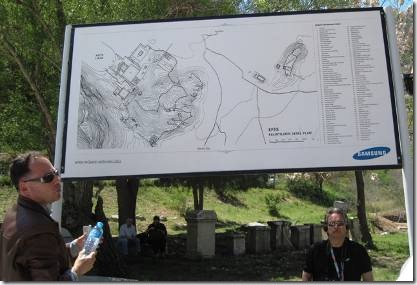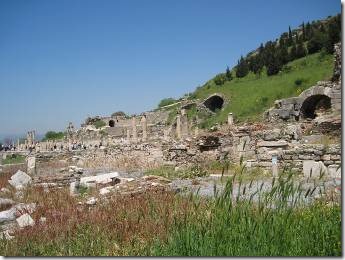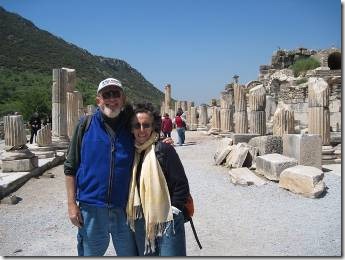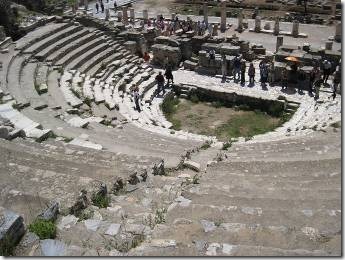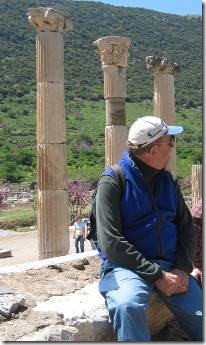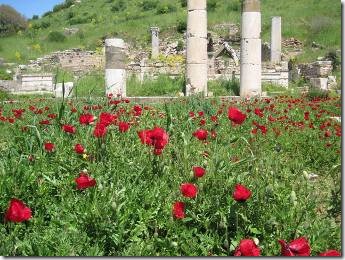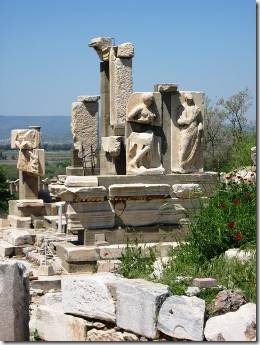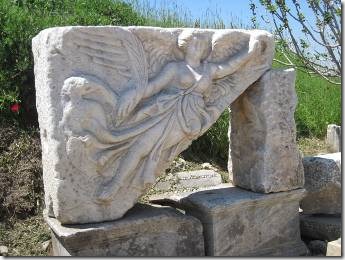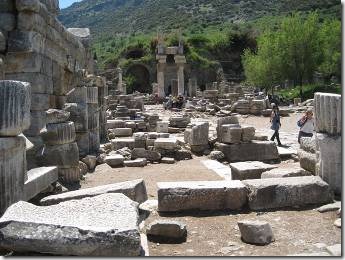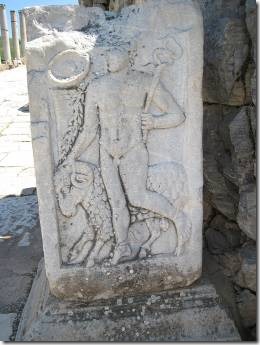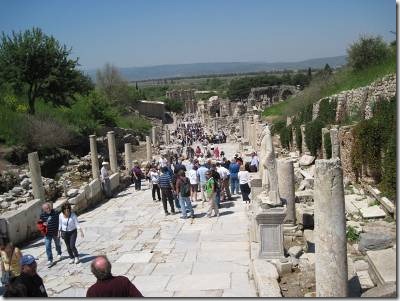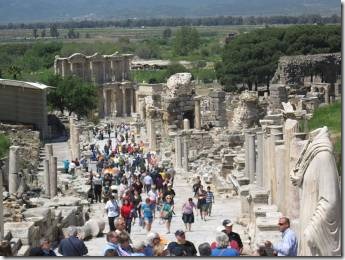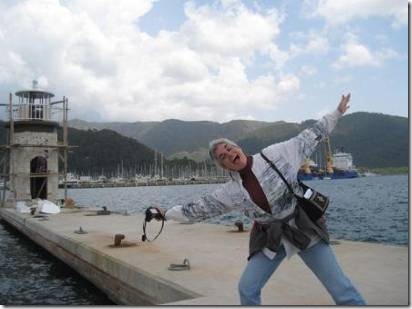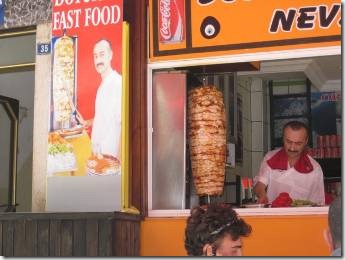In the tropics you can do your laundry at sunrise and it will be dry before 10 am. Here you do your laundry at sunrise and maybe it’s dry by 2 pm. I did laundry on Sunday and today and both times shortly after it was hung up the clouds, gloom, and the humidity rolled in. So then I had to rehang it all in the boat. A few hours later the sky cleared and then the laundry went back out. I’m going to have to rethink this laundry thing to match the spring Mediterranean weather. There’s a morning net (communications network among the cruisers) which among other things gives a weather report. It comes on at 9 am. The report today was for high humidity and bad drying weather. But between the late sun and the wind it all eventually dried. Most of the day is cold (to us) or cool, but midday is almost hot. And I’m not quite sure if rainy season has past so an umbrella is pretty necessary even if the sun is shining when you start out. I left mine behind the other day and regretted it when it started to rain. But Marmaris wet isn’t the bone cold of Istanbul wet so it’s okay.
Today besides laundry I continued to try to straighten up and clean the boat. We have way too many books so I decided to take a bagfull over to the library. I walked first to Juliet dock to say hello to Linda and Michael who were waiting for a sailmaker to come about making a new sail for them. They lightened my load taking magazines and several paperbacks. Then I continued to the library managing not to get lost. I came away with two paperbacks, both Oprah books; but I have room now on "my" bookshelves. I stopped at the marina grocery for some Coke light, eggs and dark chocolate. I need the chocolate after a meal of veggies and white cheese which is really like feta but tastes better because it tastes fresher and not so salty. Wifi is still a bit iffy.
Ru
Ephesus Ancient Site
The Smithsonian Life List
28 Places to See Before You Die
http://www.smithsonianmag.com/specialsections/lifelists/lifelist-ephesus.html
By Helen Starkweather
Smithsonian magazine, January 2008
“Over the centuries, a succession of empires—Greek, Persian, Roman, Byzantine and, finally, Ottoman—ruled over the city of Ephesus. Yet no matter how many times it changed hands, the city remained one of the most vibrant metropolises of the ancient world. Located on Turkey’s western coast, nearly 300,000 people lived there at its height, in the second century A.D. Its busy seaport ferried goods from Asia to Greece, Italy and beyond.
Ephesus’ greatest claim to fame was its temple to the goddess Artemis. One of the "seven wonders" of the ancient world, it was almost four times larger than the Parthenon in Athens. According to the New Testament, the Apostle Paul preached in Ephesus, prompting a riot led by silversmiths who crafted shrines to the goddess and feared for both their livelihoods and the future of the temple.
Today, a few columns are all that remain of the temple. But there is still much to see that evokes the city’s former splendor. A three-tiered theater, built into the slope of a hill, once seated 25,000. Just outside the city stands the Church of Saint John, built in the fourth century over the evangelist’s presumed tomb and expanded into a basilica some 200 years later.
Jodi Magness, an archaeologist at the University of North Carolina at Chapel Hill who has visited Ephesus more than a dozen times, says the city "is almost like a snapshot in time. You get the sense of what walking down the street of a Roman city was like without having to use your own imagination."
Read more: http://www.smithsonianmag.com/specialsections/lifelists/lifelist-ephesus.html#ixzz1Kvp8YVkv
Our guide Jem showing us the layout of Ephesus.
Jem was very knowledgeable and made it lots more interesting than it would have been to just wander. But I just soaked up the sun and marveled at the ruins and took lots of photos rather than notes so I can’t tell you lots facts other than what our oddly translated guide book says. “The city of Ephesus was first established on the shore of the bay at the point where Cayster River (Kucuk Menderes) falls into the sea and on the slopes of Mt. Pion (Panayar Dagr.) When the alluviums carried by this river filled the bay, it was moved to the southwest of the mountain, that is the slopes of Mt. Koressos (Bulbul Dagi.) ….Since the port of Ephesus was completely filled with alluviums carried by the Cayster River at the beginning of the Middle Ages, Ephesus became smaller since it was no more a port city or trade center. When it was captured by the Seljuks (original Turks) in 1090, it was a small village. Ephesus was completely left after it went through a short glorious period in the 14th century.”
As soon as you arrive you’re dazzled by all of the ruins.
These particular ruins are part of the Varius Baths. According to the guide book we bought, the baths included a frigidarium (cold room,) apodyterium (undressing room,) tepidarium (lukewarm room,) calidarium (hot room,) and sudatorium (sweating room.) The Baths were heated with the hot air passed through below the floor called “hypocaust.”
It’s easy to feel young when everything around you is ancient!
The Oedum, Agora and the Basilica
The Odeum was used for municipal meetings and concerts for the wealthier Ephesians. It was built by P. Vedius Antonius and his wife Flavia Papiana in the 2nd century A.D. and could seat 1500 people. The State Agora was built during the reign of Emperors Augustus and Claudius in the 1st Century AD. Religious and state meeting were held there. The Basilica was a trade center during the Roman Empire. Guide Book
Doric, Ionian and Corinthian
Remember when you had to know which was which and why.
Poppies are everywhere.
The Memmius Monument built in the 1st century AD for the family of Memmius who was the grandchild of dictator Sulla.
A relief of the goddess Nike, the winged messenger also associated with victory is just across from the Memmius Monument.
I think these are the ruins of the hospital but they aren’t shown in the guide book for me to double check.
This relief was near the hospital and I’m not sure if it is Hermes and the caduceus or Asclepius, the god of healing with a single snake symbol called the rod of Asclepius. Apparently there is a controversy as to which is the real symbol of the medical profession.
Curetes Street
“During the period of the Roman Empire, the priests dealing both with religious and state affairs were called the curetes. Since the bases of the columns with the names of these priests inscribed on them were found at the beginning of the street, it was called the Curetes Street.” Guide Book The guide book also says that there is a sewage system under the street. The end of Curetes Street going back toward the Odeum is narrows with columns on either side to prevent chariots from going any further along the way.
Curetes Street looking toward the Celsus Library
Next stop the Scholastikia Baths and the Temple of Hadrian

